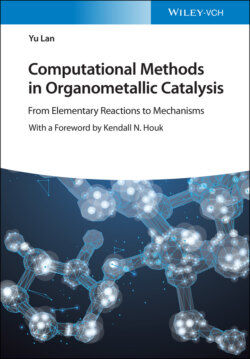Читать книгу Computational Methods in Organometallic Catalysis - Yu Lan - Страница 35
2.4 Solvent Effect
ОглавлениеSolvent effect is very important in organometallic chemistry; therefore, in theoretical calculations, it should be considered in energy calculations. Usually, the solvent effect in homogeneous catalysis calculations is considered by implicit solvent model.
In implicit solvent model, the solvent environment is simply considered as a polarizable continuous medium; meanwhile, the structure and distribution of solvent molecules close to the solute are not specifically described. The advantage of implicit solvent model is that it can represent the average effect of solvents without the consideration of various possible molecular arrangements of solvent layer as explicit solvent model does, and it does not increase the computational time. Therefore, it is widely used in the field of computational organic and organometallic chemistry. The weakness of the implicit solvent model is that the strong interaction between solvent and solute cannot be represented, such as hydrogen bond. Moreover, the accuracy of solvation energy for ionic solute case is significantly lower than that of neutral solute case.
In implicit solvent model, the solvent effect can be divided into polar and non‐polar parts. The polar part, which is the main body of the implicit solvent model, reflects the electrostatic interaction between solvent and solute molecule, and also includes the polarization of solute electron distribution contributing by solvent. The nonpolar part reflects various nonelectrostatic interactions between solute molecule and solvent, which includes the solvent exclusion energy, the influence of solute molecule on the entropy effect of solvent, and the dispersion between solute molecule and solvent.
The frequently used implicit solvent model is a polarizable continuum model (PCM) [88], in which the solvation free energy can be decomposed into three terms
in which Ges represents the electrostatic energy, Gdr represents the dispersion–repulsion energy, and Gcav represents the hole energy. All those three terms are calculated by a hole defined by a chain of van der Waals spheres centered on the solute atoms. Dielectric formulation (D‐PCM) is the early member of PCM family, which only includes the charge density of the solute wavefunction within the solute surface into the solute–solvent interaction. The integral equation formalism polarizable continuum model (IEF‐PCM), developed by Cances and Mennucci, also includes the charge density of the wavefunction beyond the solute surface into the solute–solvent interaction [89]. The conductor‐like polarizable continuum model (C‐PCM), developed by Barone and Cossi, is the implementation of conductor‐like screening model in the PCM framework, which works well for solvents with a high dielectric constant such as water solvent [90, 91]. In isodensity polarizable continuum model (I‐PCM) and self‐consistent IPCM (SCI‐PCM), the solute cavity can be defined as a surface with a constant electron density (isodensity surface) [92].
In computational organometallic chemistry, SMD (solvation model based on density), proposed by Cramer and Truhlar in 2009, is almost the best implicit solvent model for DFT calculations at present [93]. In the SMD model, the bulk electrostatic contribution is calculated on the basis of the IEF‐PCM protocol.
